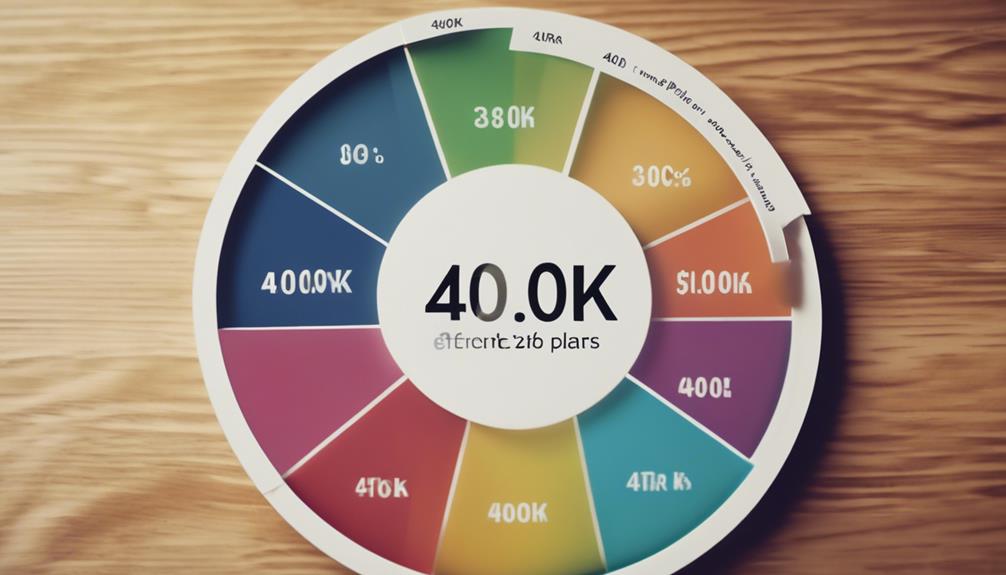When it comes to retirement planning, there are several options to consider in order to ensure your financial security. Defined benefit and defined contribution plans are commonly utilized, each offering different advantages for saving towards retirement. Additionally, there are specialized retirement plans that are designed for specific groups such as government employees or the self-employed, providing customized savings solutions. Personal retirement accounts, including traditional IRAs and Roth IRAs, offer flexibility in future planning. Innovative options like Health Savings Accounts and Target Date Funds also provide distinct benefits. Understanding and exploring these choices can help in making well-informed decisions about your retirement investments.
Key Takeaways
- Defined Benefit Plans and Defined Contribution Plans are common.
- IRAs offer tax advantages and tailored investment choices.
- Specialized Retirement Plans cater to specific groups.
- Employer-Sponsored Retirement Plans include matching contributions.
- Personal Retirement Accounts offer traditional and Roth options.
Types of Defined Benefit Plans
Within the domain of retirement planning, we encounter various types of Defined Benefit Plans. These plans, such as the Employee Pension Plan, offer a secure retirement income stream by promising a specific benefit upon retirement. In defined benefit plans, the plan sponsor assumes the responsibility of managing assets and ensuring the funding for the plan, which comes from employer contributions, investments, and sometimes even employee contributions.
One important aspect of defined benefit plans is the protection provided by the Pension Benefit Guaranty Corporation (PBGC). This insurance safeguards the benefits of participants in case of plan termination or financial distress, adding an extra layer of security to the retirement savings.
While defined benefit plans offer a predictable income stream during retirement, they've become less common today due to their cost and complexity. However, for those looking for a stable and guaranteed source of income in retirement, exploring the options within defined benefit plans can still prove beneficial.
Common Defined Contribution Plans

When contemplating retirement planning, it's crucial to be familiar with common defined contribution plans like:
- 401(k)
- IRAs
- Roth 403(b)
These plans offer various benefits such as pre-tax contributions, tax-deferred growth, and employer matches. Understanding the nuances of each plan can help individuals make informed decisions about saving for retirement.
Types of 401(k)
Among the common types of 401(k) plans are the Traditional 401(k), Roth 401(k), 403(b), 457(b), and SIMPLE 401(k) plans.
Traditional 401(k) plans allow pre-tax contributions and potential employer matching, while Roth 401(k) plans offer after-tax contributions and tax-free withdrawals in retirement.
Employees of public schools and nonprofit organizations can opt for 403(b) plans, while state and local government workers may benefit from 457(b) plans which share similarities with 401(k) plans.
For businesses with fewer than 100 employees, the SIMPLE 401(k) plan mandates employer contributions.
These employer-sponsored retirement plans provide valuable opportunities for individuals to save and invest for their future, ensuring financial stability and power in retirement. Many people may be unaware that some retirement plans in life insurance policies also offer similar benefits, combining life coverage with the potential for growth in retirement savings. By integrating retirement and insurance, these plans provide flexibility and security for both the policyholder’s beneficiaries and long-term financial goals. As a result, they can be a vital tool in comprehensive retirement planning.
Benefits of IRAs
Maximizing our retirement savings strategy greatly benefits from the tax advantages offered by IRAs (Individual Retirement Accounts). Traditional IRAs provide tax-deferred growth on investments, allowing us to potentially grow our retirement nest egg more quickly.
On the other hand, Roth IRAs offer the advantage of tax-free withdrawals in retirement, giving us flexibility and control over our tax obligations. It's crucial to be mindful of contribution limits set by the IRS to maximize our savings within the rules.
Additionally, IRAs offer a broad range of investment choices, empowering us to tailor our portfolios to our risk tolerance and financial goals. Understanding the benefits of both traditional and Roth IRAs can help us make informed decisions to secure a powerful retirement future.
Roth 403(b) Overview
Roth 403(b) plans are common defined contribution retirement options for employees of public schools and nonprofits. They offer after-tax contributions for tax-free withdrawals in retirement. Here are some key points about Roth 403(b) plans:
- Contributions are made after-tax, enabling tax-free withdrawals later.
- Similar benefits to Roth IRAs, with tax-free growth and qualified withdrawals.
- Choice between traditional 403(b) and Roth 403(b) options based on savings strategy.
- Annual contribution limits of up to $20,500 for individuals under 50 and $27,000 for those 50 and older in 2022.
- Available to employees of public schools and nonprofits, providing a powerful tool for retirement planning.
Employer-Sponsored Retirement Plans

Employer-sponsored retirement plans, such as 401(k) and 403(b) options, provide valuable benefits to employees. Matching contributions from employers can greatly enhance retirement savings, while vesting schedules determine when these contributions become fully owned by the employee. Understanding these features helps individuals make informed decisions about their financial future.
Matching Contributions
Matching contributions in retirement plans are voluntary contributions made by employers to employees' retirement accounts. Employers may match a certain percentage of an employee's contributions, up to a specified limit, as an incentive for employees to save for retirement. These contributions can vary by employer, with some offering dollar-for-dollar matches while others may provide a percentage match based on the employee's contributions.
By taking advantage of matching contributions, employees can significantly boost their retirement savings over time, helping them reach their financial goals faster. It's crucial for employees to understand their employer's matching contribution policy to maximize their retirement savings potential.
- Matching contributions boost retirement savings
- Employers may offer different types of matches
- Understanding employer policies is crucial
- Maximizing matching contributions accelerates financial goals
- Taking full advantage is key to retirement savings
Vesting Schedules
Moving from the consideration of matching contributions in retirement plans, employees should be aware of how vesting schedules impact their ownership of employer contributions in employer-sponsored retirement plans.
Vesting schedules, whether cliff vesting or graded vesting, determine when employees fully own the employer contributions made to their retirement accounts. This ownership is important as it directly affects the amount of retirement benefits employees can take with them if they leave the company before becoming fully vested.
To maximize retirement savings, understanding the vesting schedule and its implications is essential. Employees should review their plan documents to know the specific vesting rights granted to them by their employer.
Personal Retirement Accounts

Exploring personal retirement accounts sheds light on the diverse investment options available to individual investors, with traditional and Roth choices offering flexibility for long-term financial planning. When considering personal retirement accounts, keep in mind the following key points:
- Personal retirement accounts, like IRAs, offer traditional and Roth options, providing greater investment flexibility compared to employer-sponsored plans.
- Contribution limits for personal retirement accounts are generally lower than those for employer-sponsored plans, but they still offer valuable tax advantages.
- SEP IRAs are designed for self-employed individuals, featuring higher contribution limits than regular IRAs, making them an attractive option for entrepreneurs.
- Solo 401(k) plans are ideal for self-employed individuals, allowing for both employer and employee contributions, maximizing retirement savings potential.
Understanding the nuances of personal retirement accounts can help individuals tailor their retirement planning to their specific financial goals and circumstances.
Specialized Retirement Plans

Specialized retirement plans cater to specific groups such as state and local government employees, federal employees, military personnel, self-employed individuals, and small business owners. These plans are tailored to meet the unique needs and circumstances of these individuals, offering them targeted ways to save for retirement. Here is a table outlining some of the specialized retirement plans available:
| Plan Name | Target Audience | Key Features |
|---|---|---|
| 457(b) plans | State and local government employees | Deferred compensation plans allowing pre-tax contributions. |
| Thrift Savings Plan (TSP) | Federal employees, Military personnel | Low-cost retirement savings plan with various investment options. |
| Solo 401(k) | Self-employed individuals | Enables higher contribution limits and flexibility in investment choices. |
| SIMPLE IRAs | Small business owners | Easy to set up and maintain, ideal for businesses with fewer employees. |
These plans empower individuals to take control of their financial futures, ensuring they have the resources they need to enjoy a comfortable retirement.
Emerging Retirement Savings Options

Innovation continues to reshape retirement savings options, introducing new avenues for individuals to secure their financial futures. As the landscape evolves, several emerging retirement savings options are gaining traction:
- Health Savings Accounts (HSAs) offer triple tax benefits for qualified medical expenses, making them a growing option for retirement savings.
- Target Date Funds (TDFs) are becoming popular by adjusting asset allocation based on the investor's target retirement date to manage risk effectively.
- Robo-advisors provide automated investment management, simplifying retirement saving and making it more accessible.
- Socially Responsible Investing (SRI) aligns retirement savings with personal values by investing in ethically sound companies.
- Multi-employer Retirement Plans (MEPs) are emerging as a cost-effective option for small businesses to provide retirement benefits by pooling resources.
These innovative options complement traditional retirement plans, such as IRAs and Employee Benefits, offering individuals a diverse range of choices to maximize their retirement contributions and secure their financial well-being.
Frequently Asked Questions
How Many Different Retirement Accounts Are There?
Various retirement accounts exist, such as 401(k), IRA, SEP IRA, solo 401(k), and SIMPLE IRA. Each offers distinct rules and benefits dictated by the IRS. Employer plans like 401(k) and 403(b) also provide options.
What Are the Different Types of Retirement Plans?
We'll detail various retirement plans, like 401(k), IRA, SEP IRA, solo 401(k), and SIMPLE IRA. These options offer ways to save for retirement, with differences in contribution limits, investment choices, and tax benefits.
What Is the Most Popular Retirement Plan?
The most popular retirement plan in the U.S. is the 401(k). It allows us to save pre-tax income with employer matches, offers investment options, and tax advantages. Contributions have annual limits, and early withdrawals can incur penalties.
How Many 401 K Plans Are There in the Us?
We dominate the retirement landscape with over 580,000 401(k) plans in the U.S., providing millions with a tax-advantaged path to retirement savings. Our influence grows, empowering more Americans to secure their financial future.
Conclusion
To sum up, when contemplating retirement savings, it's crucial to take into account various retirement plans available to help individuals save for their future.
From defined benefit plans to personalized retirement accounts, there are options to suit different needs and preferences.
It's vital to factor in elements such as employer-sponsored plans, specialized options, and emerging savings opportunities when planning for retirement.
By exploring these options and making informed decisions, individuals can work towards a secure financial future during their retirement years.










